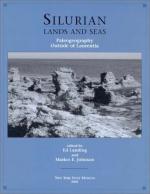|
This section contains 355 words (approx. 2 pages at 300 words per page) |
In geologic time, the Silurian Period, the third period of the Paleozoic Era, covers the time from roughly 440 million years ago (mya) until 410 mya. The name, Silurian, derives from the Silures, an ancient British tribe. The Silurian Period spans two epochs. The Early Silurian Epoch is the most ancient, followed by the Late Silurian Epoch.
The Early Silurian Epoch is divided chronologically (from the most ancient to the most recent) into the Llandoverian and Wenlockian stages. The Late Silurian Epoch is divided chronologically (from the most ancient to the most recent) into the Ludlovian, and Pridolian stages.
In terms of paleogeography (the study of the evolution of the continents from supercontinents and the establishment of geologic features), the Silurian Period featured cleavage of some supercontinent landmass and fusion of plates into Laurussia. Collision with remnants of other continents later formed the supercontinent Laurasia and eventually the super-continent Pangaea.
The fossil record establishes that the preceding Ordovician Period ended with a mass extinction. This mass extinction, approximately 440 mya, marked the end of the Ordovician Period and the start of the Silurian Period. In accord with a mass extinction, many fossils dated to the Ordovician Period are not found in Silurian Period formations. Differentiated by fossil remains and continental movements, the Devonian Period followed the Silurian Period.
The Silurian Period marked a geologically active period for volcanic activity. The accompanying ash deposits and lava flows are clearly evident in Silurian Period strata.
The fossil record indicates that it was during the Silurian Period that marine species made the evolutionary transition to terrestrial (land-based species). The first true insect fossils date to this period, as do fossils of jawed fish. Atmospheric changes, driven by increasingly diverse plant life, allowed the further development of the protective ozone layer, which filters out harmful ultraviolet radiation.
See Also
Archean; Cambrian Period; Cenozoic Era; Cretaceous Period; Dating Methods; Eocene Epoch; Evolution, Evidence Of; Fossils and Fossilization; Historical Geology; Holocene Epoch; Jurassic Period; Mesozoic Era; Miocene Epoch; Mississippian Period; Oligocene Epoch; Paleocene Epoch; Pennsylvanian Period; Phanerozoic Eon; Pleistocene Epoch; Pliocene Epoch; Precambrian; Proterozoic Era; Quaternary Period; Tertiary Period; Triassic Period
|
This section contains 355 words (approx. 2 pages at 300 words per page) |


